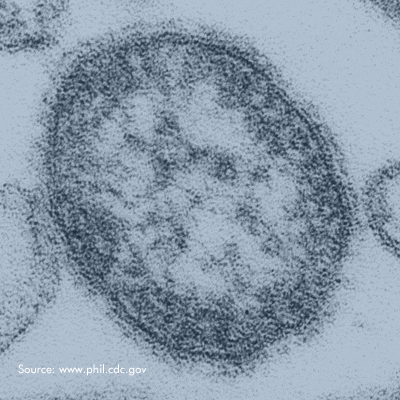| Virus | Measles Virus |
| Structure | Enveloped |
| Genome | Single stranded RNA, negative sense |
| Family | Paramyxoviridae |
| Primary Host | Humans |
| Disease(s) Caused | Measles |
| Symptoms | Four-day fevers, cough, head cold, fever, sneezing, conjuctivitis, rash |
| Potential Complications | Diarrhea, pneumonia, brain inflammation, blindness |
| Transmission Mode | Contact with infected secretions, close personal contact with infected person |
| Sites of Community Outbreaks | Schools, daycares, churches |
Importance of Measles Virus
Measles virus is an enveloped member of the Paramyxoviridae family. Its genome consists of a single, negative sense strand of RNA.
Measles virus is responsible for the disease known as measles. Measles presents as a high fever with cough, coryza, and conjunctivitis. After 2-4 days of symptoms, the characteristic red rash appears. The rash spreads over the face and torso, increasing in severity for 2-3 days. After 3-7 days, the rash begins to recede. The fever usually remains for the first few days of the rash, and the cough can persist for up to a week.
Complications of measles can include bronchitis and pneumonia, caused either by the measles virus itself or by co-infection with another pathogen. Measles can also cause encephalitis if the nervous system is infected. Blindness can occur if the patient experiences a secondary ocular infection or is vitamin A deficient, since measles reduces the levels of vitamin A in the blood.
Importance of Measles Virus Disinfection
Measles is highly contagious. Approximately 90% of those susceptible who come into close contact with a measles patient will develop the disease. Patients are contagious for the 4 days prior to and 4 days after the appearance of the rash. During this time, the virus is shed in nasal and throat secretions.
Measles is spread primarily through the airborne route. Measles has been shown to be able to survive suspended in air for at least one hour, and on surfaces for up to 2 hours.
A vaccine for measles was introduced in 1963. The vaccine is responsible for a 79% decrease in deaths from 2000 to 2014 worldwide.
Since 2000, measles has been declared eliminated from the United States. However, cases of measles still appear every year when travelers bring the virus back from countries where it is still endemic. Outbreaks also still occur among non-vaccinated populations.
As an enveloped virus, measles virus is susceptible to a wide range of disinfectants. UV room disinfection may also be effective in preventing airborne transmission.
References
Bloch, Alan B., et al. “Measles outbreak in a pediatric practice: airborne transmission in an office setting.” Pediatrics 75.4 (1985): 676-683.
“Measles.” World Health Organization. World Health Organization, Nov. 2015. Web. 20 Jan. 2016.
“Measles (Rubeola).” Centers for Disease Control and Prevention. Centers for Disease Control and Prevention, 10 Aug. 2015. Web. 20 Jan. 2016.
Orenstein, Walter A., Robert T. Perry, and Neal A. Halsey. “The clinical significance of measles: a review.” Journal of Infectious Diseases189.Supplement 1 (2004): S4-S16.
Reed, Nicholas G. “The History of Ultraviolet Germicidal Irradiation for Air Disinfection.” Public Health Reports 125.1 (2010): 15–27. Print.

